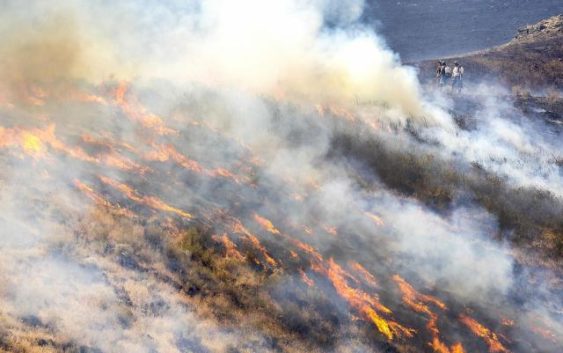- Fake job seekers are flooding the market, thanks to AI
- One set of evacuation orders lifted in Caldwell County after wildfire contained
- 'We gutted every building' | Chimney Rock rebuilding after Hurricane Helene
- 'We gutted every building' | Chimney Rock rebuilding after Hurricane Helene
- Debris from Hurricane Helene provides fuel, complicates containment for spring wildfires
Western wildfires: Crews make progress on huge Oregon blaze

BLY, Ore. — The nation’s largest wildfire raged through southern Oregon on Friday, but crews were scaling back some night operations as hard work and weaker winds helped reduce the spread of flames even as wildfires continued to threaten homes in neighboring California.
The Bootleg Fire, which has destroyed an area half the size of Rhode Island, was 40% surrounded after burning some 70 homes, mainly cabins, fire officials said.
At least 2,000 homes were ordered evacuated at some point during the fire, and an additional 5,000 were threatened.
In central Montana, five firefighters were injured when a thunderstorm and swirling winds blew a lightning-caused wildfire back on them, federal officials said Friday.
The Bureau of Land Management did not release the extent of the firefighters’ injuries or say where they were being treated.
They had joined other crews working on the 375-acre (152-hectare) Devil’s Creek fire burning in rough, steep terrain northwest of the town of Jordan. The firefighters were building a defensive fire line Thursday when the weather shifted, bureau spokesperson Mark Jacobsen said.
The fires are among many burning across the U.S. West, where extremely dry conditions and recent heat waves tied to climate change have made wildfires harder to fight.
In Oregon, the upper eastern edge of the Bootleg Fire continued to move toward Summer Lake, jumping fire lines on Thursday and prompting an evacuation order for some portions of Lake County to be raised to “Go now!” fire officials said.
Winds up to 10 mph (16 kph) could drive the flames through timber but not at the pace seen last week, when the wind-driven blaze grew exponentially, fire information officer Angela Goldman said.
The fire, which was ignited by lightning, had been expanding by up to 4 miles (6 kilometers) a day, pushed by strong winds and critically dry weather.
There was good news on the lower portion of the 625-square-mile (1,619-square-kilometer) blaze. Crews had locked in containment lines and on the lower southeastern side, they were able to gain a substantial foothold, allowing them to cut back to nighttime patrols from what had been a “24-7 run-and-gun” fight, fire information officer Sarah Gracey said.
“For us, that’s a pretty big step,” she said. “It’s not that easy to work in a pitch-black forest in the middle of the night.”
On Friday, authorities said they would be keeping an eye on changing wind conditions.
“The fire continues to throw challenges at us, and we are going to continue to stay vigilant, work hard and adapt,” Joe Hessel, incident commander for the Oregon Department of Forestry Incident Management Team, said in a statement.
That side of the blaze also had burned into an area blackened by a previous fire, creating gaps in the fuel and reducing the spread of flames through grass, shrub and timber, Gracey said.
In California, the Tamarack Fire south of Lake Tahoe has now burned more than 91 square miles (235 square kilometers) of timber and head-high chaparral of mostly national forest land, fire officials said Friday.
The fire, sparked by lightning July 4 in Alpine County, has destroyed at least 10 buildings and forced the evacuation of more than 2,400 homes. That includes about 1,300 that were ordered evacuated for the first time Thursday when blowing embers ignited a new spot fire that jumped U.S. Highway 395 north of Topaz Lake on the California-Nevada line.
Pat Seekins, operations section chief for the Rocky Mountain Incident Management Team that was called in to manage the fire, said Friday they were shifting significant resources to its eastern flank along the state line. More than 1,300 firefighters were battling the overall fire, and more resources were on their way.
Seekins said the spot fire “grew very large” very quickly. It already has burned an estimated 10 square miles (26 square kilometers).
“We had a really active day yesterday. It was pretty severe,” he said. “It’s a very significant spot fire, and it’s going to take a lot of work. That will be a very high priority for us today.”
The Douglas County Board of Commissioners in Nevada declared a state of emergency and set up evacuation sites at a senior center and the Topaz Estates community center. Neighboring Lyon County opened one at Smith Valley High School.
Crews also continue to provide structure protection farther west in California near Markleeville, Woodfords and Crystal Springs south of California Highway 88, but the worst danger has passed there, Seekins said.
Mandatory evacuation orders were issued Friday in Butte County, California as the Dixie Fire continued to grow explosively eastward, becoming the state’s largest wildfire so far this year. On Thursday, officials in Plumas County in the Sierra Nevada west of the Nevada line also ordered evacuations.
“This fire is outpacing us at moments,” Shannon Prather, the incident commander, said Thursday evening.
The fire had burned more than 223 square miles (577 square kilometers) as of Friday morning, fire officials said. It destroyed at least eight buildings and threatened at least 1,500 more.
Gov. Gavin Newsom’s office announced Thursday evening that the California Department of Forestry and Fire Protection acquired 12 additional firefighting aircraft, and nine were immediately dispatched to fires. Cal Fire now has more than 60 airplanes and helicopters.
Climate change has made the West much warmer and drier in the past 30 years and will continue to make weather more extreme and wildfires more frequent and destructive.
___
Associated Press videographer Haven Daly contributed from Gardnerville, Nevada.